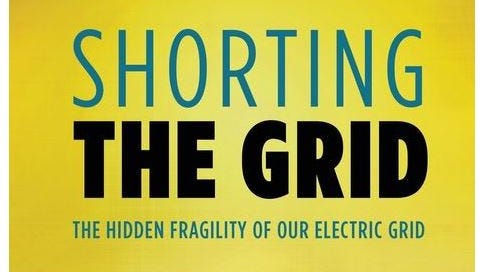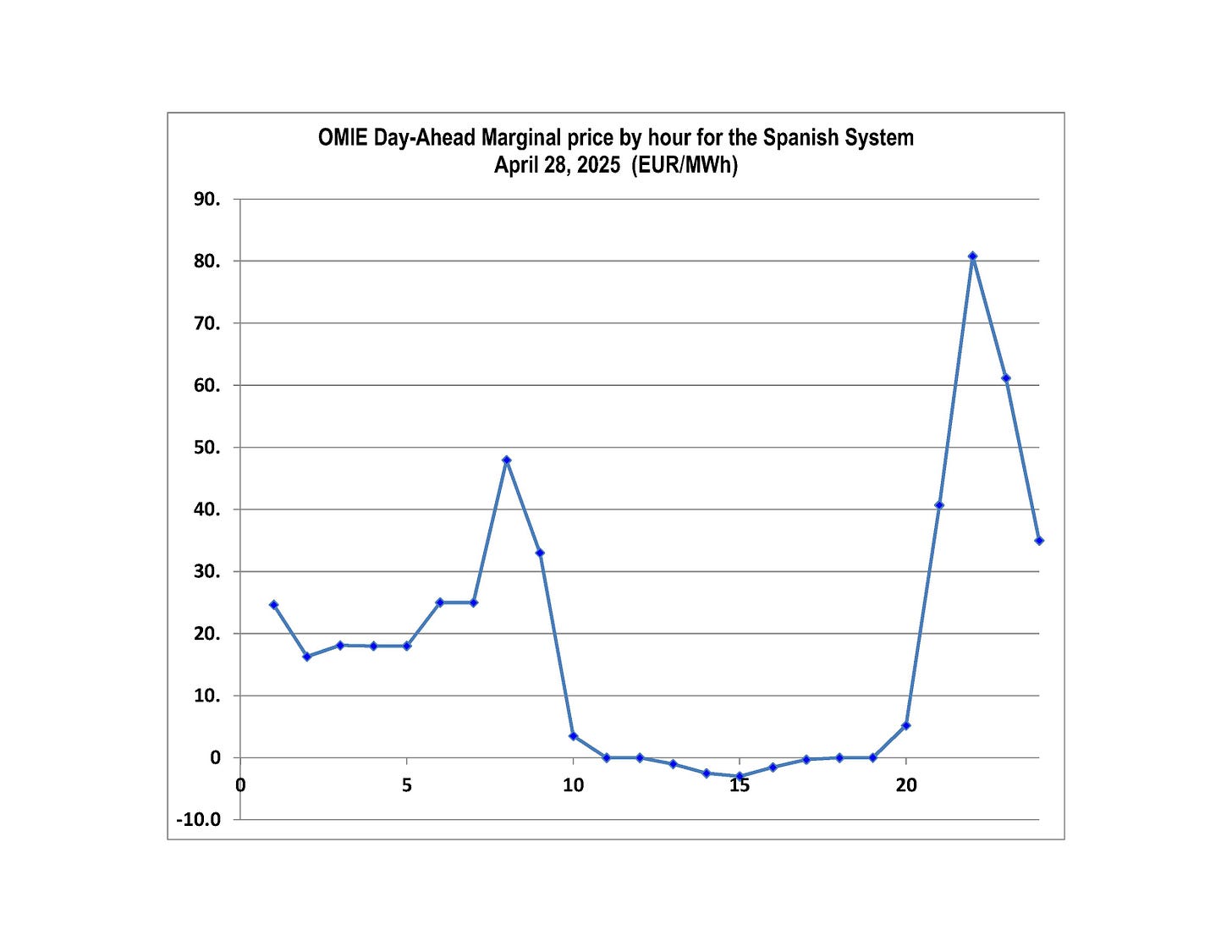The Spanish Version of the 'Duck Curve' is a real killer
This curve underscores the problem of insufficient synchronous grid inertia in Spain on April 28, 2025
The underlying cause of the April 28, 2025 Iberian Peninsula blackout is a problem with what Meredith Angwin calls the “policy grid” in her landmark 2020 book, Shorting the Grid: The Hidden Fragility of Our Electric Grid https://www.amazon.com/Shorting-Grid-Hidden-Fragility-Electric/dp/1735358002/
The policy grid in the case of Spain is the government’s clearly stated goal of powering a modern European industrial society primarily with solar and wind power at mid-day. This coalition government, which has a narrow political majority, goes by the name PSOE or “Partido Socialista Obrero Español.” https://pes.eu/member/partido-socialista-obrero-espanol-spanish-socialist-workers-party/
The power engineering problem introduced by such an aspiration is the lack of synchronous grid inertia (SGI) that maintains grid frequency stability when the electric power grid is inevitably perturbed. For background, see the March 4, 2024 GreenNUKE article, “Why is Grid Inertia Important? Without sufficient synchronous grid inertia, the grid becomes unstable and a blackout occurs.”
One of the attributes of nuclear power plants is they 24-7 reliably contribute typically the largest amounts of required SGI of any power plant on the grid. (On the other hand, solar, wind, and batteries contribute negligible SGI.) CGNP has previously noted that a pair of perfectly good Spanish nuclear power reactors were offline on the morning of April 28, 2025. They were Almaraz I (1,011 MW) and Cofrentes (1,064 MW.) In addition, Trillo (1,003 MW) was offline for refueling. Thus, as a consequence of the policy grid, there were only four Spanish nuclear power reactors Almaraz II, Ascó I and II, and Vandellós II operating in Spain on the morning of April 28, 2025.
Spanish Nuclear Taxes over 45% of Total Costs
Around 2010, the PSOE recognized the high level of taxpayer-funded subsidies for solar and wind generation were unsustainable. Likely as a result of this reality, they created a unique system of Spanish taxes on safe, abundant, reliable, non-polluting, and reasonably-priced Spanish nuclear power to subsidize the low-quality intermittent and unreliable power from solar and wind. These taxes (impuestos) are substantial. The taxes transformed Spanish nuclear power into relatively expensive electric power.
The Spanish nuclear taxes have risen to the level of threatening the economic viability of Spanish nuclear power plants. According to this March 24, 2025 World Nuclear Association article, “The Trillo Nuclear Power Plant, for instance, has highlighted the financial strain imposed by high taxation, with annual taxes amounting to over 45% of its total costs.” https://world-nuclear.org/news-and-media/association-news/world-nuclear-association-highlights-concerns-over-spains-energy-future Note the PSOE plan calls for all seven Spanish nuclear reactors to be shut down by 2035, with the first closure set for 2027.
The Spanish Day-Ahead market
In Spain, the principle of lowest-cost dispatch is applied to generators bidding into the market to supply the next day’s power. The day-ahead market operator in Spain goes by the acronym OMIE (Operador del Mercado Ibérico de Energía.) In a simplified form, generators supply bids for each of the 24 hours of the upcoming day. OMIE receives the bids for each hour and orders them based on cost. The associated generation capacity of each bid is also tabulated. OMIE also has a model for the anticipated demand for each hour. Conceptually, OMIE stacks the bids from low cost to high cost for each hour and determine a set of generators sufficient to supply the projected electric power demand. Once they have a stack of bids sufficiently high to meet the projected demand, the highest cost acceptable bid is what all accepted generators receive for that hour. The remaining higher-cost generators do not receive any compensation for that hour.
There are two significant problems with OMIE’s approach.
All power generators are deemed to be equally capable of powering the grid, regardless of their ability to supply SGI. Thus, solar and wind generators are deemed by Spanish government policy to be equivalent to nuclear power generators.
The partial subsidies to Spanish solar and Spanish wind tend to place those power generation technologies at the preferred position at the bottom of the cost stack. Any taxes, such as the Spanish nuclear tax unfairly burden nuclear power. Spanish nuclear power plant bids tend to be too high to be accepted at mid-day when there is abundant subsidized solar and wind power.
OMIE’s ‘Duck Curve’ for April 28, 2025
Here is OMIE’s day-ahead hourly market price curve for Spain for Monday, April 28, 2025:
Source: https://www.omie.es/en/market-results/daily/daily-market/day-ahead-price?scope=daily&date=2025-04-28
Here are the detailed hour-by hour accepted bids in Euros for the hours from 11:00 AM to 6:00 PM. The hour is the first row, the bids in Euros are in the second row. Bids were negative from 12 noon until 6:00 PM. That means generators paid the grid operator to generate power! Since solar and wind are subsidized, those generator operators still make money.
The Iberian Peninsula grid failed in about 15 seconds at about 12:35 PM on April 28, 2025
To reiterate, two perfectly good Spanish nuclear reactors were off line at noon on April 28, 2025. This pair of reactors could have stabilized the frequency of the Spanish power grid. However, the two nuclear power reactors could not be brought on line rapidly once the Spanish grid operator Red Eléctrica (REE) recognized there were harmful grid frequency oscillations detected during the morning. (All six of Spain’s nuclear power plants were likely scheduled to operate during the late evening load peak starting at 8:00 PM when solar is unavailable.) Additional details are found in this informative July 6, 2025 article at KiloVAR’s Substack:
The Iberian Blackout -The Reports
GreenNUKE made comments regarding this relevant article.
The PSOE has not been transparent regarding the role of the unique Spanish tax on nuclear power as a root cause of the blackout. Instead, the PSOE has placed a veil of secrecy over some important reports. The goal of this GreenNUKE Substack article is to shine some light on these PSOE policy errors. (Searching for “PSOE” reveals that the Party has other scandals unfolding on July 8, 2025. The Spanish political opposition [PP] is calling for the resignation of the Spanish Prime Minister. )
The cost of the preventable Iberian Peninsula Blackout
At least nine Spaniards died as a consequence of the blackout. The economic cost of the blackout is lost productivity and damaged production equipment, likely denominated in the billions of US dollars.
California’s CAISO has emulated Spain’s policies via application of renewable portfolio standards (RPS) that achieve the same result at the unique Spanish taxes on nuclear power. Unless California reverses course, the outcome will eventually match the Iberian Peninsula blackout of April 28, 2025. Watch for more details soon.










Thank you Gene and GLF for bringing the tax information to the fore. I was unaware of THAT wrinkle. Thanks for the nod. May I say I was pretty dismayed to see a redacted report given to the public This isn't James Bond folks.
Thanks, Gene, for verifying (much more elegantly) what I initially suspected and wrote about in "The Pain in Spain" right after the blackout. https://alchristie.substack.com/p/the-pain-in-spain?